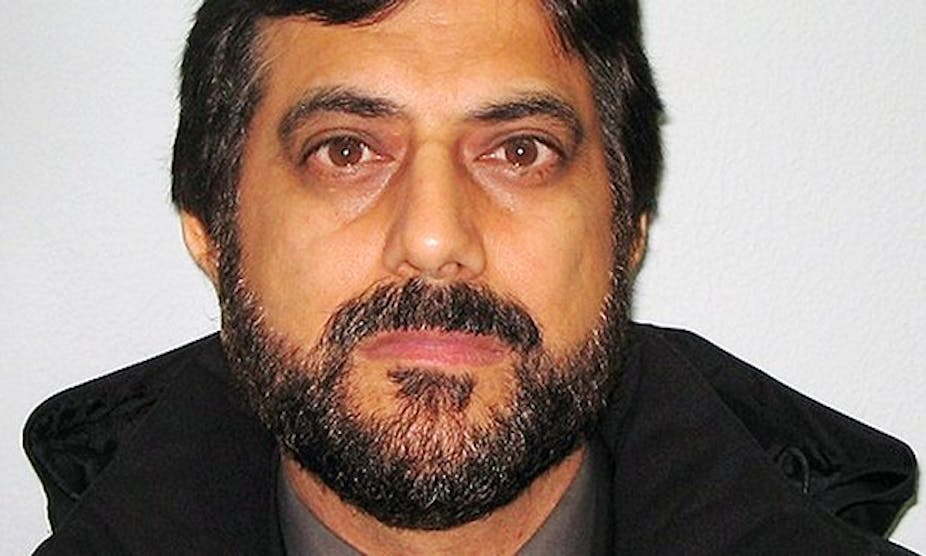The machetes of condemnation are out for the investigative journalist and self-styled “king of stings”, Mazher Mahmood. The man who dominated the British tabloid world for decades with his “fake sheikh” operation at the now defunct News of the World has been jailed for 15 months for tampering with evidence in a high-profile case.
There is something about the modern Greek tragedy in the narrative of the crusading – and to quote media commentator Roy Greenslade, “tawdry and disgusting” – tabloid entrapper, who ended up standing in the dock to face the kind of justice he wished for his many targets.
Such is the coverage his trial has received, you could be forgiven for thinking Mahmood had committed a crime much worse than the paedophilia, terrorism, class A drug supplying, arms dealing, immigration rackets, and political corruption, dodgy doctors, solicitors, pimps, judges, bent cops and even murderers that his adventures sought to expose.
In fact, he has been found guilty along with his driver, Alan Smith, of one offence: plotting to pervert the course of justice by suppressing evidence in the drugs trial of pop star Tulisa Contostavlos. The singer had been accused of arranging for Mahmood to be sold £800 worth of cocaine by one of her contacts. Her case was later dismissed after Mahmood’s evidence was called into question.
This was in the context of one of Mahmood’s elaborate stings for The Sun on Sunday, the paper he joined after Rupert Murdoch liquidated News of the World – the most successful ever Sunday newspaper – following the toxic Milly Dowler phone hacking scandal.
When the trial judge realised Mahmood had given evidence in direct contradiction to what he had said in a pre-trial hearing, Contostavlos was acquitted. The tables then dramatically turned on the journalist who had posed as a film producer and plied Contostavlos with alcohol as they discussed an acting role alongside Hollywood star Leonardo DiCaprio.

The phone hacking victims’ lawyer Mark Lewis talked about £800m of claims by Mahmood’s “past victims”. The Metropolitan Police and Crown Prosecution Service, once enthusiastic and grateful champions of Mahmood’s operations, became reverse ferrets of criminal justice.
The Crown Prosecution Service has since dropped live cases given to them by Mahmood’s alter ego and has been reviewing 25 past convictions. Six cases of high-profile figures have been taken up by the Criminal Cases Review Commission.
Notwithstanding the grinding of the wheels of justice, within the profession of journalism the methods of the “fake sheikh” have always attracted controversy. Greenslade has been on his case ever since the pair worked together on The Sunday Times. In 2006, Greenslade wrote a piece in The Independent with the headline: “Why I am out to nail Mazher Mahmood”. The formidable John Sweeney of the BBC turned Mahmood over in 2014; Channel 4 castigated Mahmood’s tactics and reputation in a documentary in 2012 which was made with the help of one of his former assistants who had turned against him.
However, this whole affair has been diminished into a reductionist fable of good and evil with no tolerance for the light and shade, moral ambiguity and rough and tumble of raucous tabloid sensationalism. The past is being judged harshly by the politics and values of the present.
Domonic Ponsford, the editor of Press Gazette, found himself under attack for suggesting that “in the race to demonise Mazher Mahmood, don’t forget his ‘victims’ were often rich people, driven by greed to do bad things”.
Ponsford faced a tsunami of critical onslaught which debunked any credit or merit for Mahmood’s investigative journalism. Nevertheless he concluded that “for me, the jury is still out on Mahmood as far as the wider allegations against him go. But I accept that given what we now know about phone-hacking at the News of the World (and elsewhere) it is best to keep an open mind when it comes to historic allegations of tabloid wrongdoing.”
How the mighty has fallen. Mahmood’s 2008 book, Confessions of a Fake Sheik: ‘The King of the Sting’ Reveals All, can be bought for a penny on Amazon. The “world’s best-known investigative journalist”, a reporter of the year in 1999, is the source of the profession’s self-loathing – Private Eye mocked his fear of reprisals and his efforts to keep his photograph out of the public eye. The Metropolitan police released his full facial image on conviction. And The Sun revealed his face complete with anorak hood and glasses that he wore to and from court.

Mahmood’s career is neither typical, nor is it the mainstay of British investigative journalism. The theatrical sting of performance journalism will always be resented by those who are embarrassed, or have something unpleasant to hide – particularly when it is teased out by the somewhat juvenile stunt of exaggerated temptation. But while subjects stung by this method might appear to condemn themselves, problems inevitably arise if this is then relied on by the state for criminal prosecutions. Mahmood and his team were tabloid journalists – not police detectives or intelligence officers.
Ultimately, however, Mahmood tampered with evidence – and for that he is now to serve time in jail. But it would be wise for the legal system, politicians and public opinion to be wary of throwing bricks in glass houses. They all once delighted and sniggered when concealing their copies of the News of the World inside The Sunday Times or the Observer and other so-called “respectable broadsheets”. Now that the morality of what went on has been judged and found wanting perhaps they should look to their own consciences and measure their condemnation with some sense of proportion.

